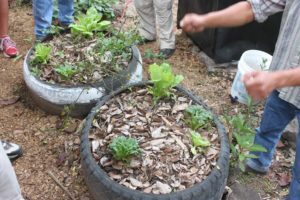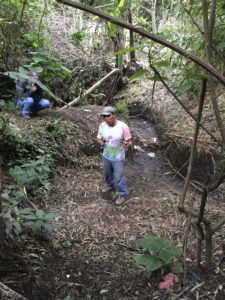Visiting IMAP (The Mesoamerican Permaculture Institute) and seeing how they work was probably one of the most intriguing and awe-inspiring activities we’ve participated in. Not only were we able to observe the composting, recycling, and water systems there, we were also able to learn a lot more about “cosmic vision”, which has influenced and shaped the lives of almost everyone in the indigenous Guatemalan society. Knowing our place in the universe and observing the daily behaviors of plants and animals are some of the cornerstones of cosmic vision. It’s really amazing how people here have taken the time to not only learn from their ancestors, but also from each other to keep finding new innovative ways of accomplishing their task.
“There is no waste in nature.” – Ronnie
[Using old tires for farming rather than risking them ending up in local lakes]
If you really ponder that quote, it makes a lot of sense. From the birth to the death of every life on this planet, waste is something that we’ve created through the lack of understanding the full use and recycling capabilities of those products. By coming up with new innovative ways to recycle and reuse most household waste, many families have been able to reduce the amount of trash they output, which would otherwise end up on the streets and/or the local water source. Although it was very different and somewhat “weird” to the most of us, using sawdust in the bathrooms instead of water seemed to be an extremely effective way to make sure that the sewer doesn’t contaminate the nearby lake. The knowledge of compost creation has allowed them to produce about 1,200 pounds of compost that can be used in IMAP crop fields each year. There were many safety precautions taken to kill the pathogens and microbes in the raw materials for compost, a process that can take months to complete but if done right saves a ton of money for this poverty-stricken society. The concept here was to not only have a temporary solution for this permanent problem, but to find a permanent and sustainable solution that could be used continuously by future generations.
“There is no straight line in nature”-Goyo
[Method to prevent flooding and sitting water during heavy rainfall]
While observing everything around us, like Ronnie said, everything in nature goes counter clock wise. Tornados, vines, the natural path of water, and dogs before they sleep are some of the examples. IMAP has incorporated these concepts throughout their gardens to more effectively make use of the space and the resources available. Furthermore, the fact that cold wind from the north during the day cools the planet and the south wind from the south at night warms the planet is another example of how our planet balances its internal temperature. This is only a small-scale example on Earth. On a bigger scale, we frequently notice the effects the moon has on our planet. Using this knowledge and more, Mayans have been able to understand the complexity of our planet, solar systems and the stars in our night sky.

